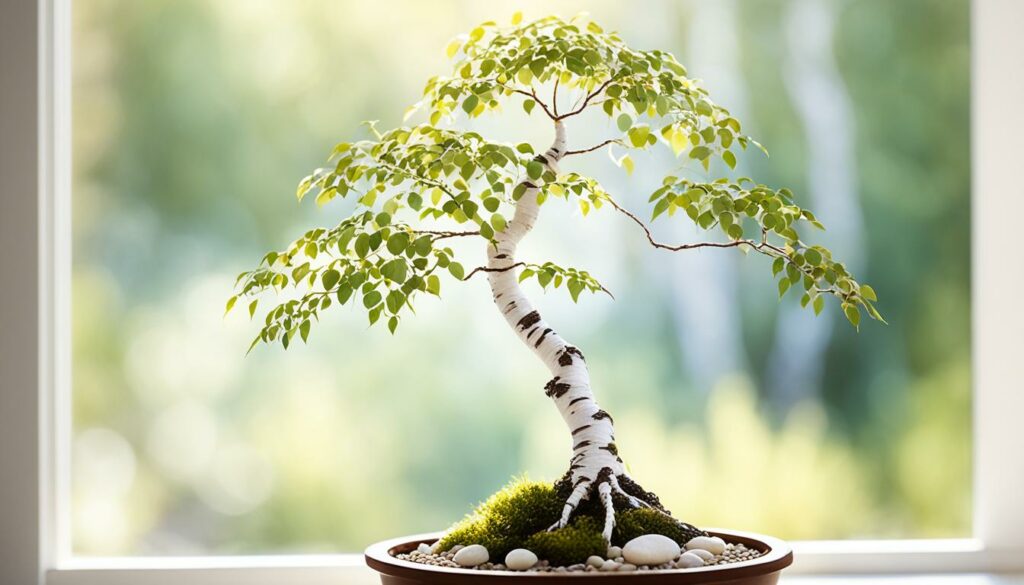Are you looking to add a unique and elegant touch to your bonsai collection? Look no further than the birch tree species. Betula bonsai, also known as deciduous bonsai, is a delicate yet striking choice for any bonsai enthusiast. In this section, we will introduce you to the graceful birch tree species and provide you with tips on caring for it for optimal health and longevity.
Key Takeaways:
- Birch bonsai, also known as Betula bonsai, adds a unique and elegant touch to any bonsai collection.
- Understanding the characteristics and traits of the birch tree species is essential for successful cultivation.
- Proper care, pruning, and shaping techniques are essential for the health and aesthetic appeal of your birch bonsai.
- Preventive measures and treatment options are available to address common issues that may affect your birch bonsai.
- Showcase the natural beauty and grace of your birch bonsai with creative and inspiring design ideas.
Understanding the Birch Tree Species
As a bonsai enthusiast, it’s essential to learn about the birch tree species and its unique characteristics that make it a perfect choice for your collection. Betula, commonly known as birch, is a deciduous tree that grows across North America, Europe, and Asia.
One of the distinctive features of the birch tree is its attractive bark, which peels in thin, papery sheets and comes in hues of white, gray, or black. This trait makes it an excellent option for bonsai cultivation as it provides an interesting textured look to the design.
Birch bonsai trees also thrive in cool climates, and their delicate leaves are small, triangular, and a bright, vivid green color that adds to their unique charm.
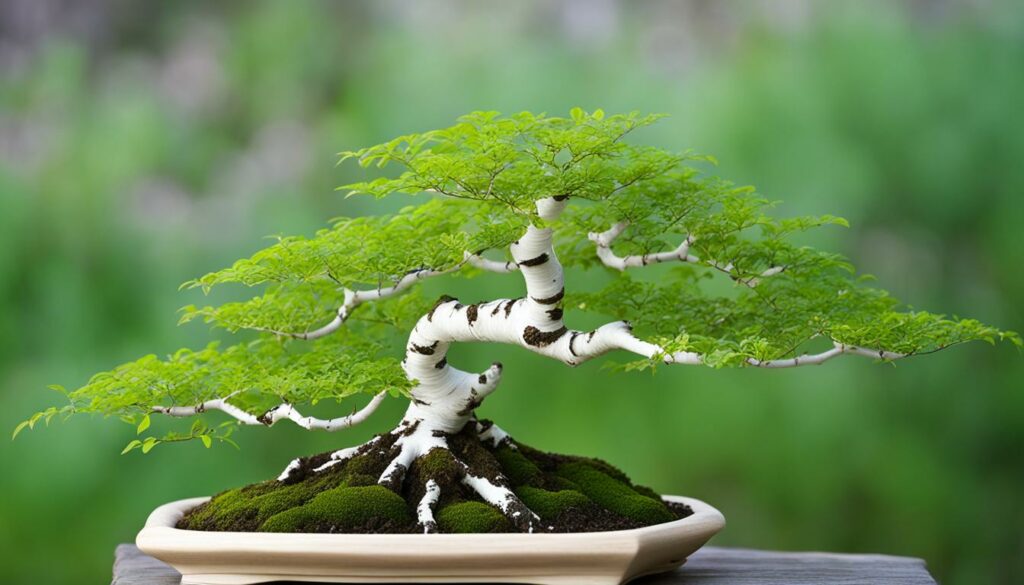
Birch Tree Growth Patterns
The birch tree species is typically a fast-growing species, which can be a challenge when growing it as a bonsai tree. However, the birch tree’s growth can be controlled by pruning, wiring, and using appropriate growing techniques.
When grown as a bonsai, the birch tree can reach up to a foot high and has a spread of up to five or six feet, making it an attractive option for miniature landscapes and accent pieces in larger designs.
Unique Features of the Birch Tree
The birch tree species offers unique features that make it an attractive option for bonsai enthusiasts. Its bark, foliage, and branching patterns are all distinct characteristics that add interest and charm to any bonsai design.
Additionally, birch bonsai trees are known for being relatively hardy and resistant to many pests and diseases. With proper care and attention, they can live for many years and continue to thrive in their miniature form.
To learn how to select the perfect birch tree for your bonsai collection, continue reading section three.
Choosing the Right Birch Tree for Bonsai
When selecting a birch tree for your bonsai collection, there are several factors to consider. It’s essential to choose a species that is suitable for bonsai cultivation, as not all birch varieties are suitable for this purpose. Betula pendula, Betula pubescens, and Betula nigra are some of the most popular birch species used for bonsai.
The next consideration is the size and age of the tree. Young trees are more flexible and easier to shape, but a mature tree will provide a more established and mature look. The trunk should be straight, with branch placement and root structure that allow for styling and design. It’s also important to look for a tree with a healthy, vigorous appearance and no signs of pests or disease.
The location where the tree was grown can also impact its suitability for bonsai. Trees grown in colder climates may develop thicker trunks and smaller leaves, making them ideal for bonsai cultivation. Carefully research and choose a tree that has been grown in an appropriate environment to ensure your success with it.
| Birch Species | Best Features | Placement |
|---|---|---|
| Betula pendula | Distinctive white bark, graceful pendulous habit | Informal upright, cascade |
| Betula pubescens | Beautiful bark textures and rich coloring | Informal upright, twin-trunk, group planting |
| Betula nigra | Attractive bark, fast-growing, suitable for informal upright style | Informal upright, windswept, group planting |
When choosing a birch tree for your bonsai, be mindful of the specific requirements of the species you select. Some birch trees need ample sunlight, while others require partial shade. Certain species prefer well-draining soil, while others thrive in moisture-rich environments. Understanding the specific needs of your chosen species is crucial for maintaining the health and vitality of your birch bonsai.
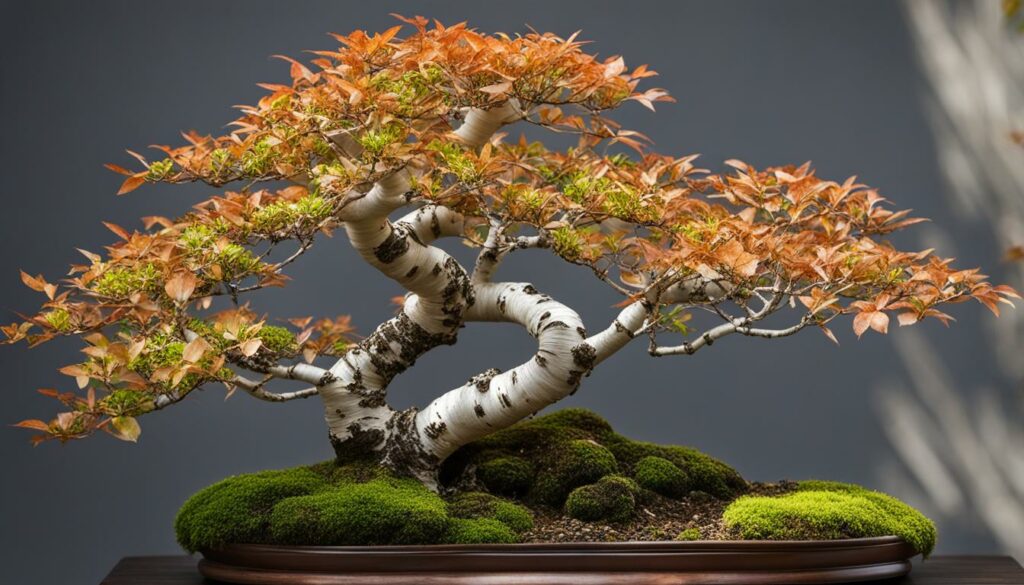
Take your time selecting the perfect birch tree for your bonsai collection. With careful consideration and attention to detail, you can find a specimen that will provide beauty and elegance for years to come.
Essential Care Tips for Birch Bonsai
Growing a birch bonsai is an engaging and rewarding experience that requires proper care. In this section, we will explore useful and essential care tips to ensure the health and longevity of your delicate birch tree.
Watering
Watering your birch bonsai is critical for maintaining its health. Since birch trees thrive in moist soil, it is essential to ensure that the soil is always moist, but not waterlogged. Your soil should never dry out completely. One effective watering technique is to use a watering can or spray bottle to slowly water around the roots, taking care to avoid the foliage and branches. It is recommended that you water your birch bonsai every day during the growing season and reduce the frequency as winter approaches.
Sunlight
Birch bonsai thrives in partial shade as young trees, and full sun exposure as they mature enhances the growth and overall health of the tree. You should place your tree in a location that receives at least six hours of indirect sunlight per day. Direct sunlight can damage the delicate bark of the tree, especially in young trees, leading to cracking and scarring.
Pruning
Pruning helps maintain the desired shape and size of your birch bonsai. It also aids in the development of new growth and stimulates the growth of the remaining branches. Regular pruning of the leaves and branches helps increase foliage density, allowing your tree to maintain its delicate appearance. To maintain its delicate and slender form, remove any crossed or broken branches, and any growth that detracts from the bonsai’s overall shape.
Soil
Birch bonsai thrives in soils that are rich in nutrients, well-draining and acidic. Plant your tree in a well-draining soil that is mixed with peat and sand for the best results. Repot your bonsai tree every two years during spring to ensure that the soil remains fertile and rich in nutrients. Keep in mind that birch tree roots are sensitive, and aggressive soil manipulation can cause root deterioration and may even lead to tree death.
Humidity
Increasing humidity around your birch bonsai tree will help it thrive. Mist the leaves and branches of your tree daily to maintain the humidity levels of the air around your bonsai. You can also place the pot of your bonsai tree on a tray of pebbles with water to improve humidity. This practice helps to mimic the tree’s natural environment, making it feel more comfortable and healthier.
Pruning and Shaping Techniques for Birch Bonsai
Pruning and shaping are essential techniques that can help you achieve the desired appearance and aesthetic appeal of your birch bonsai. Whether you want a formal upright style or a more creative and unique design, here are some techniques to consider:
Wiring
Wiring is a popular technique used in bonsai cultivation that can help you shape the branches of your birch tree and create the desired silhouette. To wire your birch bonsai, choose a pliable copper or aluminum wire that fits the thickness of the branch you want to shape. Gently wrap the wire around the branch, starting at the base and working your way up to the tip. Avoid wrapping the wire too tightly, as this can damage the branch. Once the wire is in place, bend the branch gently in the desired direction, taking care not to break it. Leave the wire on for a few months until the branch has taken the desired shape, then remove it.
Pinching
Pinching is a technique that involves removing the tips of the branches to stimulate growth and create a fuller foliage. To pinch your birch bonsai, use a sharp pair of scissors or pruning shears to cut off the tip of the branch, leaving a small stub. This will encourage the tree to produce new buds and grow more compactly. Repeat this process regularly during the growing season to maintain the shape and thickness of your birch bonsai.
Branch selection
Branch selection is an important technique that can help you achieve the desired structure and silhouette of your birch bonsai. Choose the branches that grow in the right direction and angle, and remove the ones that cross or grow in the wrong direction. This will help you create a more harmonious and balanced appearance of your tree.
Remember to prune and shape your birch bonsai regularly to maintain its health and aesthetic appeal. With proper care and attention, your birch bonsai can become a stunning centerpiece of your bonsai collection.
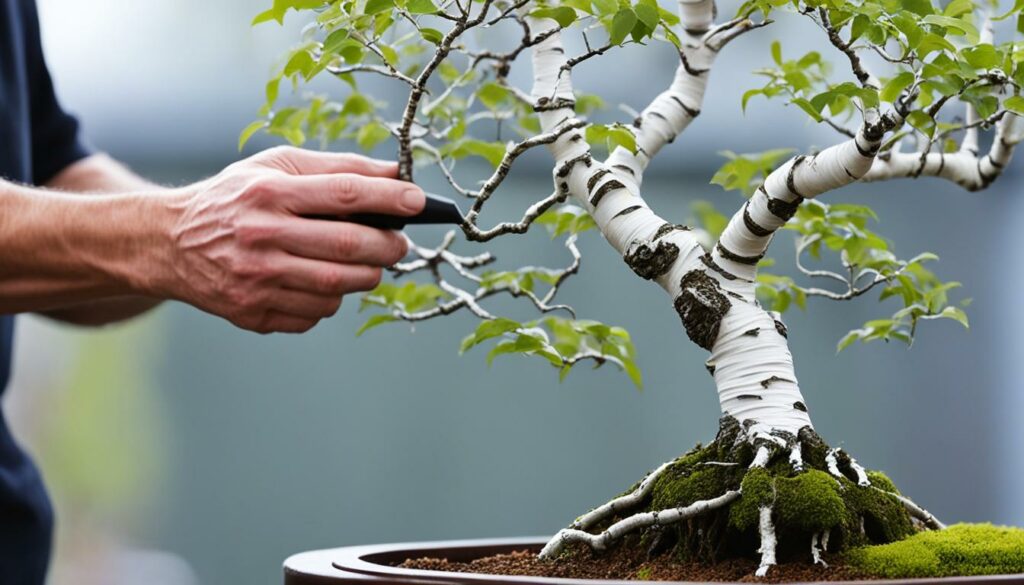
Preventing and Treating Common Birch Bonsai Issues
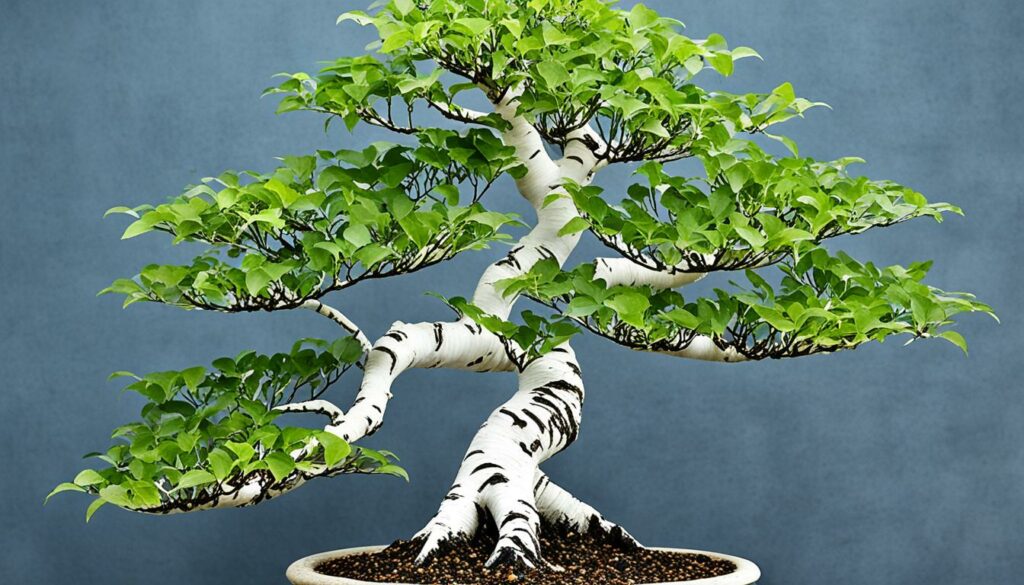
Even with proper care, birch bonsai trees can face several challenges. Understanding these issues and knowing how to prevent and treat them is crucial for maintaining the health and beauty of your tree. Here are some common issues that you may encounter:
Pests
Birch trees are susceptible to aphids and spider mites, leading to leaf damage and discoloration. To prevent pest infestations, periodically check your bonsai for signs of insects or eggs. If you detect any, use an insecticide specifically designed for bonsai trees and follow the instructions carefully.
Diseases
Birch trees are prone to developing fungal diseases like mildew or rust, especially in humid environments. To prevent these issues, ensure proper ventilation and avoid overwatering. If you notice any signs of disease, such as yellowing leaves, spots, or powder-like substances, treat your tree with a fungicide.
Environmental Stress
Birch bonsai trees can suffer from environmental stress due to harsh weather conditions or inadequate lighting. To prevent stress, maintain a suitable environment for your tree, with proper sunlight exposure and temperature regulation. Additionally, protect your tree from extreme weather conditions such as frost or intense heat.
Tip: Regularly inspecting your tree for issues and providing preventative care is much more effective than treating an already established problem.
Showcasing the Beauty of Birch Bonsai
Now that you have learned about the characteristics and care tips for birch bonsai, it’s time to showcase their beauty. Their natural grace and elegance can be displayed in various bonsai styles, from traditional to more creative designs.
A popular style for birch bonsai is the formal upright style, emphasizing the tree’s slender and elegant trunk as it rises vertically. Another style is the informal upright, with a slightly curved trunk that gives the tree a more natural and organic look.
Cascading and windswept designs can also enhance the unique charm of birch bonsai. Cascading styles allow the branches to flow downward, giving the tree a graceful and flowing appearance. Windswept designs, on the other hand, make use of the natural leaning of the trunk and branches to create a dynamic and dramatic look.
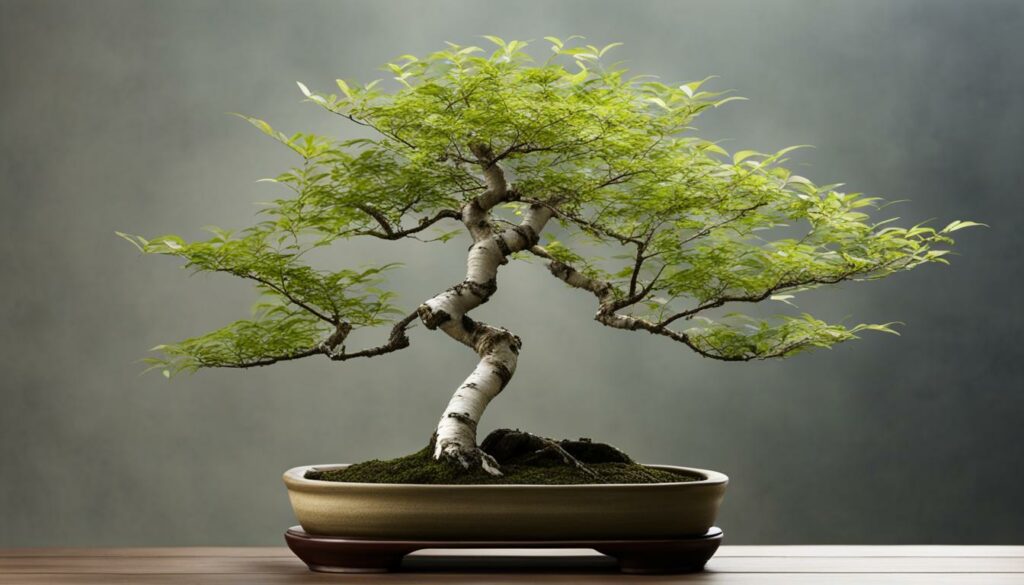
When designing your birch bonsai, consider its surroundings to create a visually pleasing display. Subtle accents such as rocks, figurines, or other small plants can bring out the tree’s natural beauty.
Conclusion
Now that you have delved into the world of birch bonsai, you have gained a newfound appreciation for this delicate and elegant tree species. By choosing the right birch variety for your cultivation, understanding its unique characteristics, and providing essential care, you can enjoy the beauty of birch bonsai in your own home.
Remember to implement the proper pruning and shaping techniques to achieve the desired appearance and showcase the natural grace of your birch tree. And in case of any common issues, such as pests, diseases, or environmental stress, follow the preventive measures and treatment options provided in this article.
With your creativity and inspiration, you can display your birch bonsai’s unique charm and elegance through traditional formal upright styles or more creative cascading or windswept designs.
Begin your journey into the world of birch bonsai and embrace the beauty and grace this species brings to your bonsai collection. Happy gardening!
FAQ
What is a birch bonsai?
A birch bonsai is a miniature version of the birch tree species, specifically cultivated and trained to grow in a bonsai pot. It is a delicate and elegant choice for bonsai enthusiasts, featuring the distinctive characteristics of the birch tree in a compact form.
How do I care for a birch bonsai?
Caring for a birch bonsai involves providing adequate sunlight, watering it regularly while avoiding waterlogging, and ensuring proper soil drainage. Additionally, pruning and shaping techniques are essential to maintain the desired appearance of your birch bonsai.
Can I keep a birch bonsai indoors?
While birch bonsai can be kept indoors for short periods, they thrive best in outdoor environments. Birch trees require a cool climate, ample sunlight, and a consistent change of seasons to support their growth and health. However, if you choose to keep your birch bonsai indoors, ensure it receives sufficient natural light and proper ventilation.
Which birch tree species are suitable for bonsai cultivation?
Several birch tree species are suitable for bonsai cultivation, including the Betula pendula (Silver birch), Betula pubescens (Downy birch), and Betula nigra (River birch). Each species has its own distinct characteristics and preferences, so be sure to research and select the one that aligns with your desired bonsai style and care requirements.
How often should I water my birch bonsai?
The frequency of watering your birch bonsai depends on various factors such as climate, soil type, and pot size. As a general guideline, monitor the moisture level of the soil and water your bonsai when the top inch of the soil feels slightly dry. Avoid overwatering or allowing the soil to completely dry out, as both can be detrimental to the health of your birch bonsai.
Can I fertilize my birch bonsai?
Yes, fertilizing your birch bonsai is essential to provide it with the necessary nutrients for healthy growth. Use a balanced bonsai fertilizer during the growing season, following the instructions provided on the product. Apply the fertilizer at regular intervals, taking care not to overfertilize, as this can damage the roots of your birch bonsai.
How do I prune my birch bonsai?
Pruning your birch bonsai is crucial for maintaining its shape and health. Start by removing any dead or unhealthy branches, followed by trimming excessive growth and shaping the foliage. It is recommended to prune your birch bonsai during the dormant season to minimize stress on the tree.
How can I prevent pests and diseases in my birch bonsai?
To prevent pests and diseases in your birch bonsai, regularly inspect the tree for any signs of infestation or infection. Maintain good hygiene practices, such as removing fallen leaves and debris, to minimize the habitat for pests. Additionally, provide proper air circulation, sunlight exposure, and avoid overwatering to create unfavorable conditions for pests and diseases.
Can I wire my birch bonsai for shaping?
While wiring can be used for shaping your birch bonsai, it should be done with extreme caution. Birch trees have delicate branches that are prone to scarring and damage from wire. If you choose to wire your birch bonsai, use a softer wire and regularly monitor the branches to prevent wire bite and adjust as necessary.
